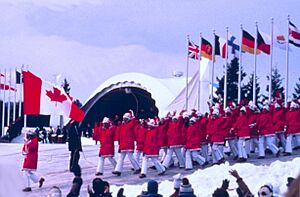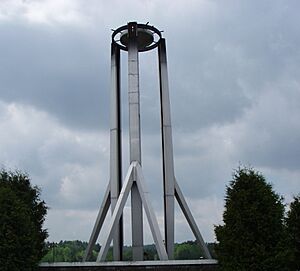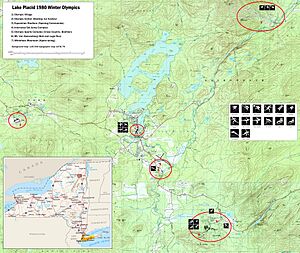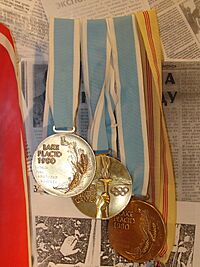1980 Winter Olympics facts for kids

Emblem of the 1980 Winter Olympics
|
|||
| Host city | Lake Placid, New York, United States | ||
|---|---|---|---|
| Nations | 37 | ||
| Athletes | 1,072 (840 men, 232 women) | ||
| Events | 38 in 6 sports (10 disciplines) | ||
| Opening | 13 February 1980 | ||
| Closing | 24 February 1980 | ||
| Opened by | |||
| Cauldron |
Charles Morgan Kerr
|
||
| Stadium | Lake Placid Equestrian Stadium | ||
| Winter | |||
|
|||
| Summer | |||
|
|||
The 1980 Winter Olympics, also known as Lake Placid 1980, was a big international sports event. It happened from February 13 to 24, 1980, in Lake Placid, New York, United States.
Lake Placid was chosen to host the 1980 Winter Games in 1974. This was the second time this small village in Upstate New York hosted the Winter Games. They had hosted them before in 1932. Lake Placid was the only city left to bid for the 1980 games. Other cities like Vancouver had dropped out. These games were the second Olympics in a row held in North America. The 1976 Summer Olympics were in Montreal, Canada.
Some buildings from the 1932 Games were updated for 1980. Events took place at places like the Olympic Center and Whiteface Mountain. The Games were great for sports. However, there were problems with transportation. The 1980 Games were the last to be held in a small city. Lake Placid had fewer than 15,000 people.
The Lake Placid Winter Olympics brought together 1,072 athletes. They came from 37 different countries. They competed in six sports and 10 different types of events. There were 38 official events in total. This was one more than in 1976. Countries like China, Cyprus, and Costa Rica joined the Winter Olympics for the first time.
American speed skater Eric Heiden won a record number of medals. He won medals in all five speed skating events. The Olympic ice hockey tournament was very exciting. A young American team beat the strong Soviet team. This win became famous as the Miracle on Ice. The American team then went on to win the gold medal. In other sports, Soviet Nikolaj Zimjatov won three gold medals in cross-country skiing. Skier Hanni Wenzel from Liechtenstein won her country's first two gold medals in alpine skiing. The Soviet Union won the most gold medals, with ten. East Germany won the most medals overall, with 23. The United States came in third for both gold medals and total medals.
Contents
Choosing the Host City
Lake Placid had tried to host the Olympic Games many times before. They bid for the Games seven times after hosting in 1932. These bids included 1948, 1952, and 1956. Three of their bids were supported by the United States Olympic Committee (USOC). These were for 1968, 1976, and 1980. But each time, Lake Placid did not get chosen.
For the 1976 Winter Games, Denver was first chosen to host. But Denver later decided not to host. The USOC then supported Salt Lake City to take Denver's place. However, Salt Lake City's plan fell apart in 1973. This was because they couldn't get enough money. Also, people in Utah were not happy about it. Lake Placid then made a quick bid for the 1976 Games. This was to make sure the selection process didn't stop completely. The International Olympic Committee (IOC) chose Innsbruck, Austria for 1976. Lake Placid came in second place. The IOC President, Lord Killanin, later said they favored Austria. This was to make up for a past decision. They had stopped Austrian skier Karl Schranz from competing in 1972.
Lake Placid did not give up. They sent the same plans they used for the 1976 bid to the USOC in 1973. They made their official bid for 1980 in September 1974. The USOC wanted to be sure Lake Placid had strong support. They were embarrassed by Denver's withdrawal. Lake Placid showed that its residents and government widely supported the bid. A vote in October 1973 showed 75% support. The New York Legislature and the Congress of the United States also supported it. The Governor of New York and the President of the United States sent letters of support. Lake Placid even got support from environmental groups.
Three other cities also wanted to host the 1980 Winter Games. These were Vancouver (Canada), Lahti (Finland), and Chamonix (France). Lahti and Chamonix dropped out early. Vancouver also withdrew because its government did not support the bid. Vancouver later hosted the 2010 Games. The IOC members chose Lake Placid for the 1980 Winter Games. This happened on October 23, 1974, in Vienna.
| City | NOC | Votes |
|---|---|---|
| Lake Placid | Unanimous | |
| Vancouver—Garibaldi | Withdrew | |
| Chamonix | ||
| Lahti |
World Events During the Games
The Lake Placid Games happened during a time of tension between countries. This period was known as the Cold War. Many other important world events were also happening. In November 1979, 62 Americans were taken hostage at the United States Embassy in Tehran, Iran. This situation lasted until after the Games.
In December 1979, the Soviet Union invaded Afghanistan. Because of this, United States President Jimmy Carter asked other countries to boycott (not attend) the 1980 Summer Olympics in Moscow. Western countries first thought about boycotting the Moscow Games on December 20, 1979. This was in response to the situation in Afghanistan. The idea of a boycott had been around before. Human rights groups had suggested it in the mid-1970s. They wanted to protest how the Soviet Union treated its people. But at that time, few governments were interested.
However, the idea became popular in January 1980. Soviet scientist Andrei Sakharov called for a boycott. On January 14, 1980, the Carter Administration joined his call. They set a deadline for the Soviet Union to leave Afghanistan. If they didn't, countries would boycott the Games. On January 26, 1980, Canadian Prime Minister Joe Clark also announced Canada would boycott. This would happen if Soviet forces did not leave Afghanistan by February 20, 1980. President Carter also suggested moving the Olympics to Greece permanently. This would stop politics from affecting where the Games were held. But the International Olympic Committee (IOC) said no. In the end, 66 nations did boycott the 1980 Summer Olympics. But this did not affect the Lake Placid Winter Games.
Another ongoing issue was the conflict between People's Republic of China and Taiwan. Taiwan had competed as "Republic of China" with its national flag until the 1976 Winter Games. In October 1979, the IOC recognized the Olympic Committee of the People's Republic of China. China had threatened to leave the Games if this didn't happen. The IOC then made Taiwan use the name "Chinese Taipei". They also had to use a new flag for the 1980 Games. Taiwan challenged this decision in a Swiss court. But the court upheld the decision on January 15, 1980. The Taiwanese team refused to follow the IOC's decision. They arrived at the Olympic Village with their old flag and name. They were not allowed to enter. So, the Taiwan team did not take part in the Games. The People's Republic of China, which had threatened to withdraw if Taiwan used its old name, took part in its first Olympic Games since 1952. It was also their first Winter Games ever.
Organizing the Games
The Lake Placid Olympic Organizing Committee (LPOOC) was created in December 1974. It was a non-profit group. It had a board of 48 people. Ron MacKenzie helped a lot to get the Games for Lake Placid. He was the head of the committee when it started. He passed away in December 1978, before the Games began. J. Bernard Fell became the chairman. Art Devlin was the vice-chairman. The LPOOC wanted to keep the Games simple. They wanted to go back to the basic ideas of the Olympic movement.
Money for the Games
The money needed for the 1980 Winter Olympic Games grew a lot. It started at $30 million. It ended up costing $168.7 million. The money came from three sources. The US government paid $82.7 million. New York State paid $32.4 million. The organizing committee paid $53.6 million. A study in 2016 looked at how much Olympic Games went over budget. It found that the Lake Placid Winter Olympics had the biggest cost overrun for any Winter Games. It was 324% more than planned.
The extra costs were due to several reasons. These included protecting the environment. Also, existing buildings needed a lot of updates. The first cost estimates were too low. And prices went up over time. The Games ended with a debt of $8.5 million. The organizing committee asked for more money but was refused. They thought they might have to declare bankruptcy. But in January 1981, the Governor of New York said the state would pay the remaining debt.
The construction of new buildings was paid for by the government and New York State. This cost $92 million in total. This included $22.7 million for the Olympic Village. The Olympic Center cost $16.9 million. The alpine ski center at Whiteface Mountain cost over $15 million. Other costs included transport improvements and security. The organizing committee's main costs were for running the Games and for press and broadcasting centers.
The rising costs and claims of favoritism led to an investigation. A government auditor looked into the LPOOC. There were questions about how money was handled and contracts were given out. The marketing director of the LPOOC was replaced. Another director had to resign. This happened when it became public that they had not paid income taxes for several years.
The LPOOC got money from sponsors. Over 200 companies signed contracts. This brought in about $30 million in cash, goods, or services. They also sold rights to broadcast the Games. This brought in $21 million.
About 550,000 tickets were sold for the 1980 Winter Olympic Games. Most tickets went to people in the United States (65.8%). Some went to Canada (6%) and other countries (8.2%). The rest were given to sponsors, officials, and others. Ticket prices for the public ranged from $15 to $70.
Safety and Security
The New York State Police and 26 other groups handled security for the Lake Placid Winter Games. The Federal Bureau of Investigation was one of these groups. The organizing committee also hired a private security company. The security main office was in Ray Brook. This was also where the Olympic Village was located. Police officers learned how to handle hostage situations. Special sensors were put in place to detect any attacks. A tall, double fence was built around the Olympic Village.
Getting Around
The Lake Placid Winter Games had many problems with transportation. This made planning and running the Games difficult. Lake Placid is a small mountain town. It was not ready for the 50,000 visitors expected each day. Most places to stay in town were for officials and athletes' families. This meant visitors had to travel up to 90 miles each day to get to events.
Because of these challenges, the LPOOC did not allow private cars in Lake Placid during the Games. Instead, they set up parking lots and a shuttle bus system. This was to take visitors to the event locations. They hired 60 taxis and 300 buses. These were for athletes, coaches, officials, and important guests.
The first sign of transport problems came a year before. At a ski jumping competition in February 1979, there was an 11-mile traffic jam. Once the Games started, the poor transport planning was clear. American and Soviet athletes arrived late for the opening ceremony. During the Games, Lake Placid's main street was often blocked by traffic. Journalists, visitors, and athletes waited a long time at bus stops. Visitors were often left stuck. They missed events or couldn't get home. After five days, Governor Hugh Carey declared a partial emergency. This was to help fix the problems.
The LPOOC said the transport problems were due to poor communication. They blamed transport companies and the state government.
Look and Feel of the Games
The Emblem (logo) of the 1980 Olympic Winter Games has several symbols. The right side looks like the mountains around Lake Placid. The left side is a fancy Ionic Column. This column reminds people of the Ancient Olympics. The dip at the top of the column looks like two bowls. These bowls stand for the two times Lake Placid hosted the Games. On the Games poster, the Olympic rings are above this emblem.
Exciting Moments
Here are some of the most exciting things that happened:
- The United States men's ice hockey team won the gold medal. Most of the players were from college. No one expected them to do well. Their 4–3 win over the strong Soviet team became known as the "Miracle on Ice". The Soviet team had won the last four Olympic gold medals. This win made Americans very happy. The win against Finland actually secured the gold medal.
- Eric Heiden from the United States won gold in all five speed skating events. He set four Olympic records and one world record. He won 83% of America's gold medals. The only other gold was from the hockey team. Heiden was the first person to win all five speed skating events. He is still the only athlete to win five gold medals at one Winter Games.
- Sweden's Ingemar Stenmark won both the giant slalom and the slalom in skiing.
- Hanni Wenzel won the women's giant slalom and slalom. This made Liechtenstein the smallest country to have an Olympic champion.
- Ulrich Wehling from East Germany and Irina Rodnina from the USSR won their events for the third time. Wehling won in Nordic combined. Rodnina won in pairs figure skating.
- Aleksandr Tikhonov from the USSR won his fourth straight gold medal. This was as part of the 4 × 7.5 km biathlon relay team.
- Nikolay Zimyatov from the USSR won three gold medals in cross-country skiing.
- Robin Cousins won gold for Great Britain in men's singles figure skating.
- East Germany won the most medals overall (23). But the USSR won more gold medals (10 vs. 9).
- In a very close race, Sweden's Thomas Wassberg beat Finland's Juha Mieto. He won the 15 km cross-country skiing by just 0.01 seconds. This was the closest win ever in Olympic cross-country skiing.
- The People's Republic of China joined the Olympic Games for the first time. This happened after the IOC agreed to call Taiwan "Chinese Taipei". China did not win any medals.
- Lake Placid 1980 was the first time artificial snow was used in Olympic competitions.
Sports at the Games
There were 38 events in 6 sports (10 different types of events). Here are the sports:
|
|
Places Where Events Happened
- Intervales Ski-Hill – For Nordic combined (ski jumping) and Ski jumping.
- Lake Placid Equestrian Stadium – Where the Opening Ceremony took place.
- Lake Placid Olympic Sports Complex Cross Country Biathlon Center – For Biathlon, Cross-country skiing, and Nordic combined (cross-country skiing).
- Mt. Van Hoevenberg Bob and Luge Run – For Bobsleigh and Luge (they had separate tracks).
- Olympic Center – For Figure skating, Ice hockey, and the Closing ceremonies.
- James B. Sheffield Speed Skating Oval – For Speed skating.
- Whiteface Mountain – For Alpine skiing.
The old Will Rogers Memorial Hospital was used as the press headquarters for a short time.
Lake Placid was a good choice because it already had buildings from the 1932 Winter Olympics. The Bobsleigh run was a key example. These existing places meant the Olympics could be held without spending too much money. It also helped protect the environment.
The local Olympic committee needed money from Congress to build the Olympic Village. Congress said they needed a plan for what would happen to the buildings after the Olympics. It was decided that the Olympic Village would be built to meet the needs of the Federal Bureau of Prisons. After the Games, it became the Federal Correctional Institution, Ray Brook.
Medal Winners
These are the top ten countries that won medals at the 1980 Winter Games.
* Host nation (United States)
| Rank | Nation | Gold | Silver | Bronze | Total |
|---|---|---|---|---|---|
| 1 | 10 | 6 | 6 | 22 | |
| 2 | 9 | 7 | 7 | 23 | |
| 3 | 6 | 4 | 2 | 12 | |
| 4 | 3 | 2 | 2 | 7 | |
| 5 | 3 | 0 | 1 | 4 | |
| 6 | 2 | 2 | 0 | 4 | |
| 7 | 1 | 5 | 3 | 9 | |
| 8 | 1 | 3 | 6 | 10 | |
| 9 | 1 | 2 | 1 | 4 | |
| 10 | 1 | 1 | 3 | 5 | |
| Totals (10 entries) | 37 | 32 | 31 | 100 | |
Countries That Competed
37 different countries (National Olympic Committees) took part in the Games.
Cyprus made its first Olympic appearance at these Games. The People's Republic of China and Costa Rica also made their first Winter Olympic appearance. The Republic of China (Taiwan) refused to attend the Games. This was because the IOC recognized the People's Republic of China as "China". The IOC also asked the Republic of China to compete as "Chinese Taipei". The People's Republic of China returned to the Olympics for the first time since 1952. It was their first Winter Olympic Games. However, they later boycotted the 1980 Moscow Summer Olympics.
| Participating National Olympic Committees |
|---|
|
Mascot
Roni was the Olympic mascot for these Games. Don Moss created him. Roni is a racoon. Racoons are common animals in the Adirondack mountains, where Lake Placid is located. The name Roni comes from the word racoon in Iroquoian. This is the language of the native people from the New York State and Lake Placid area. Children from Lake Placid schools chose the name.
Theme Song
The official theme song for the 1980 Winter Olympics was "Give It All You Got". It was performed by American flugelhorn player Chuck Mangione. He played the song live at the Closing Ceremony. The Hamilton Philharmonic Orchestra from Canada joined him.
See also
 In Spanish: Juegos Olímpicos de Lake Placid 1980 para niños
In Spanish: Juegos Olímpicos de Lake Placid 1980 para niños






